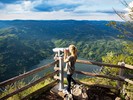The island of Santorini (Thira) is most impressive when approached from the sea as you sail into the massive caldera (sea-filled volcanic crater), almost totally enclosed by sheer cliffs ranging in height between 200 and 400 meters. Along the grey-black lava cliff tops, the whitewashed settlements of Fira and Oia are the island's most alluring (and most expensive) destinations. In fact, Santorini lives almost entirely from tourism, attracting visitors with its extraordinary landscape and its ancient archaeological sites. It is generally marketed as a romantic destination - popular with honeymooners, couples, and celebrities. Cruise ships sailing the East Mediterranean make a one-day port of call here.
1 Fira
The capital of Santorini, Fira (Thira) is made up of whitewashed cubic houses and terraces, winding lanes, little squares, and blue-domed churches perched on the cliffs 300 meters above the caldera. Below town, from the small port of Skala, Fira can be reached either by walking or riding (mules are for hire) up the steep and winding stepped path (587 steps) or by taking the cable-car. Ferries dock at the port of Athinios, connected to Fira by road (17 kilometres), while cruise ships put down anchor in the caldera, and passengers are transported to Skala by tender. Fira lives principally from tourism, and many of its buildings are now given over to small hotels, apartments, restaurants, cafes, souvenir shops, and jewellers.
2 Oia
On the northern tip of Santorini, 12 kilometres up the coast from Fira, ia (Oia) is a picture-perfect village of whitewashed houses, several of which have been converted into chic little boutique hotels with infinity pools, overlooking the caldera. Like Fira, it lives from tourism, but caters for a more upmarket clientele. Steep paths zigzag up to town from Ammoudi Bay, where you'll find a row of waterside seafood eateries. Oia is especially known for its stunning sunsets, which attract visitors from all over the island each evening through summer. It's possible to walk all the way from Oia to Fira following a footpath along the cliffs high above the caldera (allow three hours).
3 Caldera
Formed by the massive volcanic explosion that blew the center out of the island some 3,600 years ago, the caldera is the sea-filled volcanic crater that remained. Measuring 12 kilometres by seven kilometres, it is still home to volcanic activity - in its center rise the two Kaimeni islets with hot springs and gas emissions. Various agencies offer one-day excursions of the caldera by boat, including time to bathe in the hot springs and then have lunch on Thirassia, a tiny island on the west side of the caldera affording amazing views back to Santorini across the water.
4 Akrotiri Archaeological Site and Red Beach
Near the village of modern Akrotiri, 12 kilometres southwest of Fira, the ancient settlement of Akrotiri was buried below lava following the 16th-century BC volcanic explosion that created the caldera. Excavations have shown that Santorini was a flourishing and prosperous island before the eruption and probably lived from shipping and trading. Its connections with North Africa can be deduced from the outstanding frescoes (most of which are now in the National Archaeological Museum in Athens) that decorated its houses. Akrotiri reopened to the public in 2012, following several years of closure. Nearby is the famous Red Beach below a spectacular red cliff wall. The beach is accessible along a path from the town of Akrotiri.
5 Ancient Thira
On the southeast coast, Ancient Thira dates from the ninth century BC. You can see the ruins of Hellenistic temples and other structures, as well as the foundations of Roman and early-Byzantine buildings. Finds from the site are displayed in the archaeology museum in Fira.










